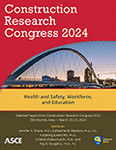Building Diversity in the Construction Industry: Examining Hiring and Performance Evaluation Practices for Equipment Operators under the Trend of Technology Transformation
Publication: Construction Research Congress 2024
ABSTRACT
The construction industry has been male-dominated for a long time and has struggled with diversity and inclusion in the workforce, especially for construction equipment operators with only 2.7% of women. Meanwhile, the construction industry is also currently facing the emergence of new technologies such as construction robots. This trend may offer new opportunities for increasing diversity and inclusion in the workforce, but it also poses the risk of exacerbating existing inequities without a well-designed transformation process of hiring and performance evaluation. This study aims to examine the current state of hiring and performance evaluation practices for equipment operators and identify the barriers and challenges to creating a more diverse and inclusive workforce, especially in the context of the incorporation of construction robots. Specifically, through content analysis of job posters and a series of interviews with industry professionals, this study identifies the reasons that prevent women from entering this occupation, the existing barriers, and the potential impacts of emerging technology adoptions on workforce diversity. The findings of this study provide valuable insights for the construction industry to build a more diverse and inclusive workforce in the technology transformation process.
Get full access to this article
View all available purchase options and get full access to this chapter.
REFERENCES
Abraham, M., and Burbano, V. (2021, 03/01). Congruence Between Leadership Gender and Organizational Claims Affects the Gender Composition of the Applicant Pool: Field Experimental Evidence. Organization Science.
Agapiou, A. (2002, 2002/11/01). Perceptions of gender roles and attitudes toward work among male and female operatives in the Scottish construction industry. Construction Management and Economics, 20(8), 697–705.
Arceo-Gomez, E., Campos-Vazquez, R., Badillo, R., and Lopez-Araiza, S. (2022, 04/02). Gender stereotypes in job advertisements: What do they imply for the gender salary gap? Journal of Labor Research, 43.
Bartz, J. A., and Lydon, J. E. (2004). Close relationships and the working self-concept: Implicit and explicit effects of priming attachment on agency and communion. Personality and Social Psychology Bulletin, 30(11), 1389–1401.
Bem, S. L. (1974). The measurement of psychological androgyny. Journal of consulting and clinical psychology, 42(2), 155.
Bergelson, I., Tracy, C., and Takacs, E. (2022). Best Practices for Reducing Bias in the Interview Process. Current Urology Reports, 23(11), 319–325.
Castilla, E. J., and Rho, H. J. (2023). The Gendering of Job Postings in the Online Recruitment Process. Management Science.
Choi, J. O., Shrestha, P. P., Lim, J., and Shrestha, B. K. (2018). An investigation of construction workforce inequalities and biases in the architecture, engineering, and construction (AEC) industry. Construction Research Congress 2018.
Eng, R. (2023, March 15). Construction industry faces massive labor shortage, needs over half a million workers.
Fielden, S., Davidson, M., Gale, A., and Davey, C. (2000, 02/01). Women in construction: The untapped resource. Construction Management & Economics, 18, 113–121.
French, E., and Strachan, G. (2015, 03/20). Women at work! Evaluating equal employment policies and outcomes in construction. Equality, Diversity and Inclusion: An International Journal, 34, 227–243.
Gaucher, D., Friesen, J., and Kay, A. C. (2011). Evidence that gendered wording in job advertisements exists and sustains gender inequality. Journal of personality and social psychology, 101(1), 109.
Hoffman, C., and Hurst, N. (1990). Gender stereotypes: Perception or rationalization? Journal of personality and social psychology, 58(2), 197.
Lingard, H., and Lin, J. (2004, 05/01). Career, family and work environment determinants of organizational commitment among women in the Australian construction industry. Construction Management & Economics, 22, 409–420.
Loosemore, M., and Waters, T. (2004, 2004/07/01). Gender Differences in Occupational Stress Among Professionals in the Construction Industry. Journal of Management in Engineering, 20(3), 126–132.
Meekes, J., and Hassink, W. H. J. (2022, 2022/05/01/). Gender differences in job flexibility: Commutes and working hours after job loss. Journal of Urban Economics, 129, 103425.
Newman, M. L., Groom, C. J., Handelman, L. D., and Pennebaker, J. W. (2008). Gender differences in language use: An analysis of 14,000 text samples. Discourse processes, 45(3), 211–236.
Pratto, F., and Stewart, A. L. (2011). Social Dominance Theory. In The Encyclopedia of Peace Psychology.
Rudman, L. A., and Kilianski, S. E. (2000). Implicit and explicit attitudes toward female authority. Personality and Social Psychology Bulletin, 26(11), 1315–1328.
Schullo, S. A., and Alperson, B. L. (1984). Interpersonal phenomenology as a function of sexual orientation, sex, sentiment, and trait categories in long-term dyadic relationships. Journal of personality and social psychology, 47(5), 983.
Statistics, U. S. B. O. L. (2023, January 25). Labor Force Statistics from the Current Population Survey. https://www.bls.gov/cps/cpsaat18.htm.
Tang, S., Zhang, X., Cryan, J., Metzger, M. J., Zheng, H., and Zhao, B. Y. (2017). Gender bias in the job market: A longitudinal analysis. Proceedings of the ACM on Human-Computer Interaction, 1(CSCW), 1–19.
Wall, S., and Schellmann, H. (2021, June 23). LinkedIn’s job-matching AI was biased. The company’s solution? More AI.
Wong, K. (2020, September 14). Diversity and Inclusion in the Workplace: Benefits and Challenges. https://www.achievers.com/blog/diversity-and-inclusion/.
Information & Authors
Information
Published In
History
Published online: Mar 18, 2024
ASCE Technical Topics:
Authors
Metrics & Citations
Metrics
Citations
Download citation
If you have the appropriate software installed, you can download article citation data to the citation manager of your choice. Simply select your manager software from the list below and click Download.
